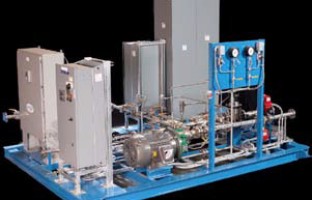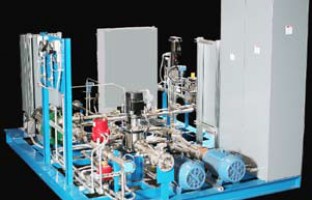GTE / Why GTE? / Case Studies / Water Injection and Power Augmentation System

Based on increasing regulatory requirements, plants are looking for technology in accordance with the emissions limit set forth by the Department of National Resources. One of our power generation customers was informed of regulatory changes in NOx emission limits on five of their simple-cycle, liquid fuel-fired combustion turbines. Regulatory requirements may vary by region and in this instance, the requirement was to reduce the emissions to 88ppmv or below. The turbines are located at four separate locations and consist of two GE Frame 5 and three P&W FT4 engines. All five units are at least 30+ years old.
This company wanted a water injection system, which injects water into the combustion to dilute the combustion process and to reduce the NOx emissions. Since the equipment is used to supplement peak demand and revenue is determined by maximum power level or capacity, the customer also sought to augment the equipment. In addition, one of the specification requirements was to have a system that did not require control air or hydraulics to operate.
GTE Engineers performed site audits to identify logistical, size, and design constraints for the system. They defined the design specific parameters for a single skid that could incorporate a water injection system with a power augmentation system and presented the design to the customer. An action plan was agreed upon to meet the specification requirements.
GTE created a single system that incorporated both the Water Injection and Power Augmentation systems. The system is capable of interfacing with virtually any control system and gas turbine fuel system. The GTE Water Injection system would provide cleaner and lower level emissions while the Power Augmentation system would provide increased output and optimized performance. GTE also employed a high-speed electronic valve to control NOx water flow rates and a water actuated stop valve to provide positive, failsafe shutoff to meet the additional specification requirement.
CHALLENGE
Today’s tighter regulatory requirements are forcing older plants that apply diffusion combustion to cease operation. As a result, plants are looking for emission reducing technology.
Recently , one of our power generation customers w as informed of regulatory changes in NOx emission limits on five of their simple - cycle, liquid fuel - fired combustion turbines. The turbines are located at four separate locations and consist of two GE MS 5001Ps and three P&W FT4A engines. All five units are at least 30+ years old and had previously upgraded controls utilizing different platforms. In accordance with the emissions limit set forth by the Delaware Department of National Resources, our customer had to reduce their emissions to 88ppmv or below; however, this requirement may vary by region.
This power generation company wanted a Water Injection system , which injects water into the combustor to dilute the combustion process, to reduce these NOx emissions. Since the equipment is used to supplement peak demands and revenue is determined by maximum power level or capacity, the customer also sought to power augment the equipment. They wanted to incorporate an Inlet Power Augmentation system onto the Water Injection skid. The systems had to have parts commonality and be compatible with multiple types of control systems and combustion turbines.

STRATEGY
GTE Engineers performed site audits to identify logistical, size, and design constraints for the system. They defined the design specific parameters for a single skid that could incorporate a Water Injection with a Power Augmentation system and presented them to the customer. The GTE Water Injection system would provide cleaner and lower level emissions while the Power Augmentation system would provide increased output and optimized performance. The customer and GTE agreed on an action plan to meet the specification requirements.
SOLUTION
With extensive experience in water injection and power augmenta tion system design, GTE created a single skid that incorporated both the Water Injection and Power Augmentation systems. The system is capable of interfacing with virtually any control system and gas turbine fuel system. One of the specification requirements was to have a system that did not require control air or hydraulics to operate. GTE employed a high-speed electronic valve to control NOx water flow rates and a water actuated stop valve to provide positive, failsafe shutoff. Power augmentation was accomplished via VFD driven positive displacement pumps for inlet water fogging. This modular, all-electronic approach created a universal fit system that easily interfaced with the two different turbine fuel and control systems.
OUTCOMES
GTE successfully implemented the combined Water Injection and Power Augmentation skids to limit NOx emissions and increase power output. After the installation, the systems were tested to specification requirements for NOx emissions levels. The power generation company has maintained consistent, emissions NOx levels that meet the Delaware Department of National Resources limit. Additionally, the increased power generation capabilities of the units have offset the need for additional standby generation and/or procurement of peak power.
Contact us today to see what GTE’s products and services can do for your facility.
